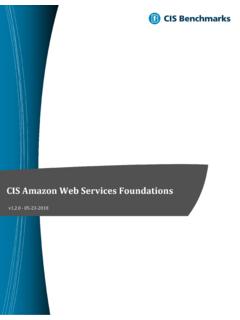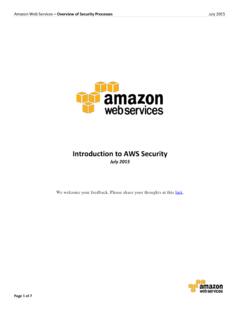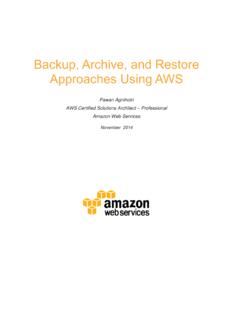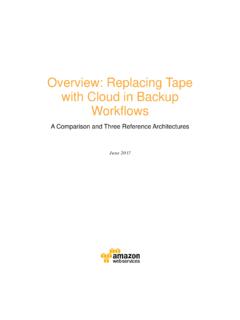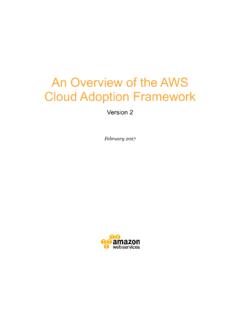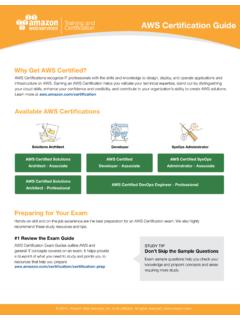Transcription of Overview of Amazon Web Services - AWS Whitepaper
1 Overview of Amazon Web Services August 2020 Notices Customers are responsible for making their own independent assessment of the information in this document. This document: (a) is for informational purposes only, (b) represents current AWS product offerings and practices, which are subject to change without notice, and (c) does not create any commitments or assurances from AWS and its affiliates, suppliers or licensors. AWS products or Services are provided as is without warranties, representations, or conditions of any kind, whether express or implied. The responsibilities and liabilities of AWS to its customers are controlled by AWS agreements, and this document is not part of, nor does it modify, any agreement between AWS and its customers.
2 2020 Amazon Web Services , Inc. or its affiliates. All rights reserved. Contents Introduction .. 1 What is Cloud Computing? .. 1 Six Advantages of Cloud Computing .. 2 Types of Cloud Computing .. 3 Cloud Computing Models .. 3 Cloud Computing Deployment Models .. 4 Global Infrastructure .. 5 Security and Compliance .. 6 Security .. 6 Compliance .. 7 Amazon Web Services Cloud Platform .. 8 AWS Management Console .. 8 AWS Command Line Interface .. 8 Software Development Kits .. 8 Analytics .. 8 Application Integration .. 14 AR and VR .. 16 AWS Cost Management .. 16 Blockchain.
3 18 Business 18 Compute .. 20 Customer Engagement .. 26 Database .. 26 Desktop and App Streaming .. 31 Developer 32 Game Tech .. 35 Internet of Things (IoT) .. 35 Machine Learning .. 42 Management and Governance .. 52 Media Services .. 60 Migration and Transfer .. 62 Mobile .. 67 Networking and Content Delivery .. 69 Robotics .. 75 Satellite .. 76 Security, Identity, and Compliance .. 77 84 Next Steps .. 87 88 Contributors .. 88 Further Reading .. 88 Document Revisions .. 89 Abstract Amazon Web Services offers a broad set of global cloud-based products including compute, storage, databases, analytics, networking, mobile, developer tools, management tools, IoT, security, and enterprise applications: on-demand, available in seconds, with pay-as-you-go pricing.
4 From data warehousing to deployment tools, directories to content delivery, over 140 AWS Services are available. New Services can be provisioned quickly, without the upfront capital expense. This allows enterprises, start-ups, small and medium-sized businesses, and customers in the public sector to access the building blocks they need to respond quickly to changing business requirements. This Whitepaper provides you with an Overview of the benefits of the AWS Cloud and introduces you to the Services that make up the platform. Amazon Web Services Overview of Amazon Web Services Page 1 Introduction In 2006, Amazon Web Services (AWS) began offering IT infrastructure Services to businesses as web Services now commonly known as cloud computing.
5 One of the key benefits of cloud computing is the opportunity to replace upfront capital infrastructure expenses with low variable costs that scale with your business. With the cloud, businesses no longer need to plan for and procure servers and other IT infrastructure weeks or months in advance . Instead, they can instantly spin up hundreds or thousands of servers in minutes and deliver results faster. Today, AWS provides a highly reliable, scalable, low-cost infrastructure platform in the cloud that powers hundreds of thousands of businesses in 190 countries around the world.
6 What is Cloud Computing? Cloud computing is the on-demand delivery of compute power, database storage, applications, and other IT resources through a cloud Services platform via the Internet with pay-as-you-go pricing. Whether you are running applications that share photos to millions of mobile users or you re supporting the critical operations of your business, a cloud Services platform provides rapid access to flexible and low-cost IT resources. With cloud computing, you don t need to make large upfront investments in hardware and spend a lot of time on the heavy lifting of managing that hardware.
7 Instead, you can provision exactly the right type and size of computing resources you need to power your newest bright idea or operate your IT department. You can access as many resources as you need, almost instantly, and only pay for what you use. Cloud computing provides a simple way to access servers, storage, databases and a broad set of application Services over the Internet. A cloud Services platform, such as Amazon Web Services , owns and maintains the network-connected hardware required for these application Services , while you provision and use what you need via a web application.
8 Amazon Web Services Overview of Amazon Web Services Page 2 Six Advantages of Cloud Computing Trade capital expense for variable expense Instead of having to invest heavily in data centers and servers before you know how you re going to use them, you can pay only when you consume computing resources, and pay only for how much you consume. Benefit from massive economies of scale By using cloud computing, you can achieve a lower variable cost than you can get on your own. Because usage from hundreds of thousands of customers is aggregated in the cloud, providers such as AWS can achieve higher economies of scale, which translates into lower pay as-you-go prices.
9 Stop guessing capacity Eliminate guessing on your infrastructure capacity needs. When you make a capacity decision prior to deploying an application, you often end up either sitting on expensive idle resources or dealing with limited capacity. With cloud computing, these problems go away. You can access as much or as little capacity as you need, and scale up and down as required with only a few minutes notice. Increase speed and agility In a cloud computing environment, new IT resources are only a click away, which means that you reduce the time to make those resources available to your developers from weeks to just minutes.
10 This results in a dramatic increase in agility for the organization, since the cost and time it takes to experiment and develop is significantly lower. Stop spending money running and maintaining data centers Focus on projects that differentiate your business, not the infrastructure. Cloud computing lets you focus on your own customers, rather than on the heavy lifting of racking, stacking, and powering servers. Go global in minutes Easily deploy your application in multiple regions around the world with just a few clicks. This means you can provide lower latency and a better experience for your customers at minimal cost.
